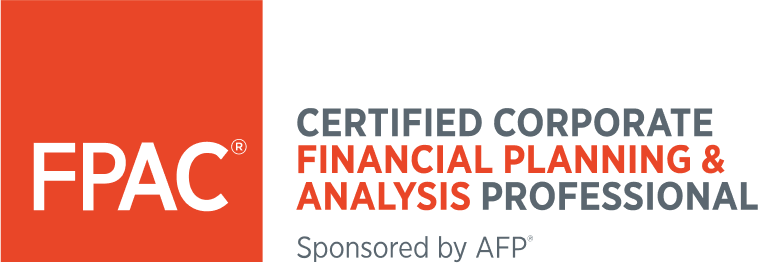FPAC Test Specifications
Using the job analysis results, a committee of volunteers with extensive FP&A field experience, developed the specifications (number of exam question items per knowledge domain) for the FPAC examination. The examination is broken down into two parts, with three domains in each part. These test specifications apply to the 2025B-2031A testing windows.
Part I – Financial Acumen
Understanding and Managing Financial Information and Business Relationships (140 Questions)
Domain A: Concepts of Business and Finance – 52-55%
Domain B:
Systems and Technology – 15-20%
Domain C: Business Partnering – 28-34%
Part II – Financial Analysis and Business Support
Building and Interpreting Financial Projections (55 Questions)
Domain A: Analysis and Projections – 40-50%
Domain B: Models and Analytics – 35-40%
Domain C: Business Communication – 13-17%
PART I
A: Concepts of Business and Finance – 52-55%
KSAs
Knowledge of types of budgets and their application (e.g., zero based, annual budgets, rolling forecasts, stretch budgets, etc.)
Knowledge of tools and resources available for various types of assessments
Knowledge of the accounting close process
Knowledge of strategic frameworks (e.g., SWOT Analysis, Porter's Five forces, growth share matrix, etc.)
Knowledge of sources of information about tax policies and their implications on projections
Knowledge of sources of information about business models, ratios and metrics of the industry
Knowledge of sources of historical information about an organization and its industry
Knowledge of risk factors and concepts (e.g., value at risk, hedging, insurance, interest rate risk, diversification, etc.)
Knowledge of managerial accounting/reporting principles
Knowledge of generally accepted accounting principles
Knowledge of general financial concepts and common financial formulas (for example, time value, opportunity costs, debt structures and covenants, earnings per share (EPS), cost of capital, etc.)
Knowledge of general business terminology, practices, processes (e.g., organization structures, compensation structures, stock options, regulatory compliance, etc.)
Knowledge of finance principles and processes
Knowledge of cost accounting principles (e.g., costs throughout the production process, fixed and variable costs, cost allocation contribution margins, etc.)
Knowledge of basic micro-economics (e.g., marginal costs, margin analysis, pricing, supply and elasticity concepts of demand, etc.)
Knowledge of basic macro-economic values (e.g., CPI, GDP, exchange rates, etc.)
Knowledge of accounting concepts and practices (e.g., accrual accounting, cash accounting, etc.)
Ability to read and interpret corporate annual reports
Ability to determine peer groups and competitors
Domain B: Systems and Technology – 15-20%
KSAs
Knowledge of user acceptance testing (UAT) during software implementation
Knowledge of spreadsheet and database structures and functions
Knowledge of software/data version control concepts and techniques (e.g., naming conventions, annotations, comments, protocols and documentation, etc.)
Ability to identify processes that can be automated and communicate desired output to the implementation team
Ability to create templates for information gathering
Ability to assess existing systems and reporting tools
Domain C: Business Partnering – 28-34%
KSAs
Knowledge of the strategic planning process
Ability to understand corporate structure and functions (e.g., hierarchy, corporate groups, the value of the group to the organization, etc.)
Ability to review a completed task and identify continuous improvement opportunities
Ability to provide input or support financial close and reporting activities
Ability to identify and quantify the benefits, pitfalls and interdependencies in strategic opportunity assessment
Ability to engage with stakeholders to achieve management expectations
Ability to define, incorporate and report on financial and/or non-financial key performance indicators
Ability to define and schedule project/work flow elements and their interaction
Ability to coordinate FP&A tasks with the corporate finance calendar or the assigned deadline
Ability to coordinate and communicate deadlines, deliverables and expectations in the work flow process
Ability to conduct surveys (e.g., to assess process efficiency, to gather qualitative data from sales force, to identify trends, etc.)
Ability to collect information about operations and determine the information needed to support operations
PART II
Domain A: Analysis and Projections – 40-50%
KSAs
Ability to synthesize information to create conclusions, alternatives and recommendations
Ability to select the appropriate financial formula for a given situation
Ability to perform variance analysis and reporting (e.g., actuals v. prior periods, actuals v. plan, actuals v. forecast, etc.)
Ability to perform PVM analyses (price volume mix)
Ability to perform competitive analysis (e.g., benchmarking, peer group analysis, ratios, etc.)
Ability to perform common statistical functions (e.g., standard deviation, expected value, correlation, regression, means, modes, etc.)
Ability to perform a risk analysis
Ability to perform and interpret capital investment calculations; such ROI, DCF and NPV
Ability to create specific customer/deal/product projections
Ability to create sales volume/revenue projections
Ability to create financial statement projections - (P&L/income statement, cash flow, balance sheet, equity statements, etc.)
Ability to create expense and head count projections (staffing)
Ability to create a financial ratio analysis (such as debt/equity, account receivable days, liquidity ratios
Ability to create a capital expenditure/investment analysis
Ability to create and perform sensitivity analyses and scenario analyses, including "what-if" scenarios and analyses
Back to top
Domain B: Models and Analytics – 35-40%
KSAs
Knowledge of the interactions/interrelationships of common financial statements
Ability to interpret common statistical functions (e.g., standard deviation, expected value, correlation, regression, means, modes, etc.)
Ability to test and validate a model (e.g., cross-footing, consistency testing, reasonableness assessment, etc.)
Ability to perform an information gap analysis (i.e., determine the information that is missing or needed to complete the task)
Ability to integrate information and data into analysis
Ability to identify outliers in data and determine the causes (i.e., data that does not seem to fit, etc.)
Ability to document models (i.e., create supporting information and protocols, document functionality and structure, etc.)
Ability to distill (combine and/or aggregate data while excluding irrelevant data) from numerous sources to create meaningful information
Ability to determine and assess the seasonality of an industry
Ability to communicate with and gather information from business partners
Ability to assess the applicability/acceptability of existing tools, processes, models, etc.
Ability to assess reasonableness of conclusions and to test conclusion against various scenarios
Domain C: Business Communication – 13-17%
KSAs
Knowledge of effective communication techniques
Ability to tailor communication style for individuals at different levels of the organization
Ability to adjust a presentation to incorporate feedback from the audience
Ability to communicate assumptions, supporting information and conclusions
Ability to create effective presentations with common presentation software
Back to top

